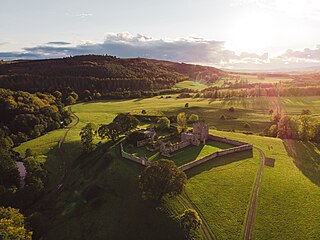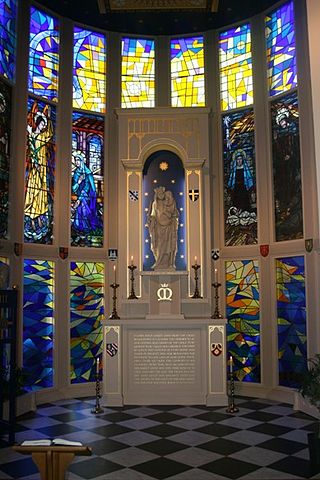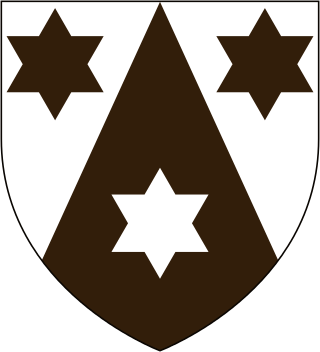
Whitefriars, also known as the White Friars or The College of Carmelites, Gloucester, England, was a Carmelite friary of which nothing now survives.

Whitefriars, also known as the White Friars or The College of Carmelites, Gloucester, England, was a Carmelite friary of which nothing now survives.
The Friary was outside the north gate of the city and was founded around 1268 or 1269, probably by Queen Eleanor, Sir Thomas Gifford (or Giffard), and Sir Thomas Berkeley. [1] [2] By 1337 there were 31 friars resident. [2]
The Friary produced some important men, including Nicholas Cantelow (Cantelupe of Gloucester) and David Bois, but by the time of the dissolution of the monasteries the Friary had declined, having only three friars remaining. According to Fosbrooke, much of the Friary was destroyed about 1567, while materials from the buildings were used to fortify Gloucester during the English Civil War. The founder's lodgings were converted to a barn during the war. During the reign of Elizabeth I, parts of the Friary had been used as the county House of Correction. The site became known as Friars' Ground. [1]
In October 2020, part of the friary was found by archaeologists after Bruton Way multi-storey car park was demolished in 2019 as part of the Kings Quarter development. [3]

Hulne Priory, Hulne Friary or Hulne Abbey was a friary founded in 1240 by the Carmelites or 'Whitefriars'. It is said that the Northumberland site, quite close to Alnwick, was chosen for some slight resemblance to Mount Carmel where the order originated. Substantial ruins survive, watched over by the stone figures of friars carved in the 18th century. It is a sign of the unrest felt in this area so near to the border with Scotland that the priory had a surrounding wall and in the 15th century a pele tower was erected. Changes were made at the Dissolution of the Monasteries when the Percy family took control.

Blackfriars, Gloucester, England, founded about 1239, is one of the most complete surviving Dominican black friaries in England. Now owned by English Heritage and restored in 1960, it is currently leased to Gloucester City Council and used for weddings, concerts, exhibitions, guided tours, filming, educational events and private hires. The former church, since converted into a house, is a Grade I listed building.

The Whitefriars Theatre was a theatre in Jacobean London, in existence from 1608 to the 1620s — about which only limited and sometimes contradictory information survives.
Ipswich Whitefriars was the medieval religious house of Carmelite friars which formerly stood near the centre of the town of Ipswich, the county town of Suffolk, UK. It was the last of the three principal mendicant communities to be founded in Ipswich, the first being the Ipswich Greyfriars (Franciscans), under Tibetot family patronage before 1236, and the second the Ipswich Blackfriars (Dominicans) founded by King Henry III in 1263. The house of the Carmelite Order of White Friars was established in c. 1278–79. In its heyday it was the home of many eminent scholars, supplied several Provincial superiors of the Order in England, and was repeatedly host to the provincial chapters of the Order.

Our Lady of Doncaster is a Marian shrine located in Doncaster, South Yorkshire, England. The original statue in the Carmelite friary was destroyed during the English Reformation. A modern shrine was erected in St Peter-in-Chains Church, Doncaster in 1973. The feast day of Our Lady of Doncaster is 4 June.
Whitefriars was a Carmelite friary on the lower slopes of St Michael's Hill, Bristol, England. It was established in 1267; in subsequent centuries a friary church was built and extensive gardens developed. The establishment was dissolved in 1538.
Sack Friary, Bristol was a friary in Bristol, England. It was established in 1266 and dissolved in 1286.
Chester Carmelite Friary, otherwise Chester Whitefriars, was a friary in the city of Chester in Cheshire, England. The Carmelites were present in Chester from the late 1270s and by the mid-14th century were established as a well-regarded community. Their church and graveyard were popular for burials of the well-to-do and the friary was often mentioned in Chester wills. Their church steeple when rebuilt in 1495 became a useful landmark for ships. The friary was dissolved in 1538. There are no surviving buildings but the street name Whitefriars preserves the memory of the community.
Wotton under Edge Friary was a friary of the Crutched Friars in Wotton-under-Edge, Gloucestershire, England.

Greyfriars, Gloucester, England, was a medieval monastic house founded about 1231.

Aylesford Priory, or "The Friars" was founded in 1242 when members of the Carmelite order arrived in England from Mount Carmel in the Holy Land. Richard de Grey, a crusader, sponsored them, and conveyed to the order a parcel of land located on his manor in Aylesford in Kent. The estate came back into the ownership of the Carmelite order in 1949. After refurbishment, which revealed 15th century remnants, the manor house was Grade I listed in 1959. After subsequent work on site, the 15th century gatehouse and the NE section of the wall were also Grade I listed on 25 February 1987. The priory now contains an array of contemporary artworks by notable artists. It is a pilgrimage destination of national significance.
Lossenham Friary was a Carmelite friary in Newenden in the Weald of Kent, England.

Boston Friary refers to any one of four friaries that existed in Boston, Lincolnshire, England.

York Carmelite Friary was a friary in York, North Yorkshire, England, that was established in about 1250, moved to its permanent site in 1295 and was surrendered in 1538.

The buildings known as Whitefriars are the surviving fragments of a Carmelite friary founded in 1342 in Coventry, England. All that remains are the eastern cloister walk, a postern gateway in Much Park Street and the foundations of the friary church. It was initially home to a friary until the dissolution of the monasteries. During the 16th century it was owned by John Hales and served as King Henry VIII School, Coventry, before the school moved to St John's Hospital, Coventry. It was home to a workhouse during the 19th century. The buildings are currently used by Herbert Art Gallery and Museum, Coventry.
Whitefriars is an area in the Ward of Farringdon Without in the City of London. Until 1540, it was the site of a Carmelite monastery, from which it gets its name.

Nottingham Whitefriars is a former Carmelite monastery located in Nottingham, England.
51°51′56″N2°14′23″W / 51.865524°N 2.239784°W